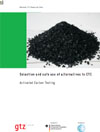Activated Carbon (AC) is a form of carbon that has been processed to make it extremely porous and thus to have a very large surface area available for adsorption. The effectiveness of Activated carbon is usually specified by the amount of a certain test chemical it can adsorb per unit weight of activated carbon used.
For Activated carbon used for filtering air and gases, the test chemical used is Carbon Tetrachloride, commonly designated as CTC and is specified as CTC Activity (%).
ONLY ALTERNATIVE
Butane activity test is the only internationally accepted
test method for measuring the porosity of the activated carbon. The butane activity is the ability of the activated carbon to adsorb butane from a mixture of dry air
and butane under specific conditions. The mass of Butane absorbed at saturation is noted and calculated
as mass of Butane per unit mass of carbon. The detailed test procedure and the specifications
of the experimental set up are provided in ASTM standard - D 5742-95 (American Society for Testing and Materials).
From the butane activity value the CTC activity of activated carbon can be calculated by using the following correlation. Both values are being used by the manufacturers alternately.
CTC Activity Number = 2.57 x Butane activity Number
|
Properties of Butane( C4H10 ) |
|
CAS Number |
106-97-8 |
|
Flammability |
Extremely flammable |
|
Flash point |
- 60oC |
|
Boiling point |
- 0.5oC |
|
Specific gravity |
0.579 g/cm3 |
|
Vapour pressure |
30 psia @ 20oC |
|
Cancer causing |
Unlikely |
Physical state |
A colorless, odorless gas |
HAZARDS TO CONSIDER
|
 |
|
Since butane is extremely flammable and can cause an accidental fire or explosion it should be handled with extreme caution. Butane activity test should be performed in fuming hood or provision should be made to vent off the discharge gas coming out from the sample tubes to a safe environment. |
FURTHER INFORMATION
Field assessments have been completed by GTZ team with the help of industries. Further tests on safety aspects such as exposure limit are being carried out.
A detailed technical document titled "Selection and Safe Use of Alternatives to CTC – Activated Carbon Testing" has been published.

Download the document here
Comments? Questions? Suggestions? Please click
here to let us know!
|
Disclaimer
Ü Though all care has been taken while researching and compiling the information presented above, GTZ Proklima accepts no liability for its accuracy. The reader is advised to confirm its correctness prior to use or purchase of any substance.
Ü GTZ Proklima makes no claim in respect of the suitability of any substance as substitute for CTC in any specific industrial process. Suitability remains to be verified through trials with due consideration of health and safety aspects.
Ü Information provided here does not constitute an endorsement or recommendation of any product by GTZ Proklima. While preference is given to non-proprietary products information on selected proprietary products may be included if they appear to have a better environment, health and safety performance or if they are already widely adopted by the industry.
|

